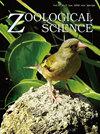Genetic Analysis Reveals Dispersal Patterns of Japanese Serow in Two Different Habitats of a Mountainous Region.
IF 0.9
4区 生物学
Q3 ZOOLOGY
引用次数: 0
Abstract
Dispersal increases the costs of feeding and predation risk in the new environment and is reported to be biased toward habitats similar to the natal region in some mammals. The benefits and costs of dispersal often differ between sexes, and most mammals show male-biased dispersal in relation to a polygamous mating system. Japanese serow is generally a solitary and monogamous species. However, recent studies have shown that the sociality of serows on Mt. Asama differs between habitat types. In the mountain forests with low forage availability, solitary habits and social monogamy were observed, while, in alpine grasslands, female grouping and social polygyny were observed, which is probably due to abundant forage availability. We investigated the effects of habitat characteristics and sociality on the dispersal of serows using fecal and tissue samples from two different habitats on Mt. Asama. The Fst value between the two areas was significantly positive, and the mean relatedness within areas was significantly higher than that between areas, which suggests limited gene flow and natal habitat-biased dispersal. Bayesian clustering analysis showed unidirectional gene flow from forest to grassland, which was probably due to the high forage availability of the grassland. Analyses of the assignment index and mean relatedness did not show male-biased dispersal, even in the grassland, where serows were polygynous. Thus, polygyny in the grassland is not linked to male-biased dispersal. In summary, our study suggests that dispersal patterns in Japanese serows are affected by habitat rather than social differences.遗传分析揭示了日本雪柳在山区两种不同生境中的散布模式。
散居会增加在新环境中的觅食成本和捕食风险,据报道,一些哺乳动物会偏向于与产地相似的栖息地。雌雄动物散居的收益和成本往往不同,大多数哺乳动物的散居与一夫多妻的交配制度有关,表现为雄性偏向散居。日本绢毛猴通常是独居和一夫一妻制的物种。然而,最近的研究表明,浅间山日本绢毛猴的社会性在不同的栖息地类型有所不同。在饲料供应较少的山林中,观察到了独居习性和社会一夫一妻制;而在高山草地上,观察到了雌性群居和社会一夫多妻制,这可能是由于饲料供应充足。我们利用浅间山两个不同栖息地的粪便和组织样本,研究了栖息地特征和社会性对雪柳扩散的影响。两个区域间的Fst值呈显著正相关,区域内的平均亲缘关系显著高于区域间的平均亲缘关系,这表明基因流动有限,且原生栖息地偏向散布。贝叶斯聚类分析显示,基因从森林向草原单向流动,这可能是由于草原的饲草资源丰富。对分配指数和平均亲缘关系的分析表明,即使在草原上也没有出现偏向雄性的散布,而草原上的雪娥是多雌的。因此,草原上的多雄性与雄性偏向散布无关。总之,我们的研究表明,日本雪柳的扩散模式受栖息地而非社会差异的影响。
本文章由计算机程序翻译,如有差异,请以英文原文为准。
求助全文
约1分钟内获得全文
求助全文
来源期刊

Zoological Science
生物-动物学
CiteScore
1.70
自引率
11.10%
发文量
59
审稿时长
1 months
期刊介绍:
Zoological Science is published by the Zoological Society of Japan and devoted to publication of original articles, reviews and editorials that cover the broad field of zoology. The journal was founded in 1984 as a result of the consolidation of Zoological Magazine (1888–1983) and Annotationes Zoologicae Japonenses (1897–1983), the former official journals of the Zoological Society of Japan. Each annual volume consists of six regular issues, one every two months.
 求助内容:
求助内容: 应助结果提醒方式:
应助结果提醒方式:


